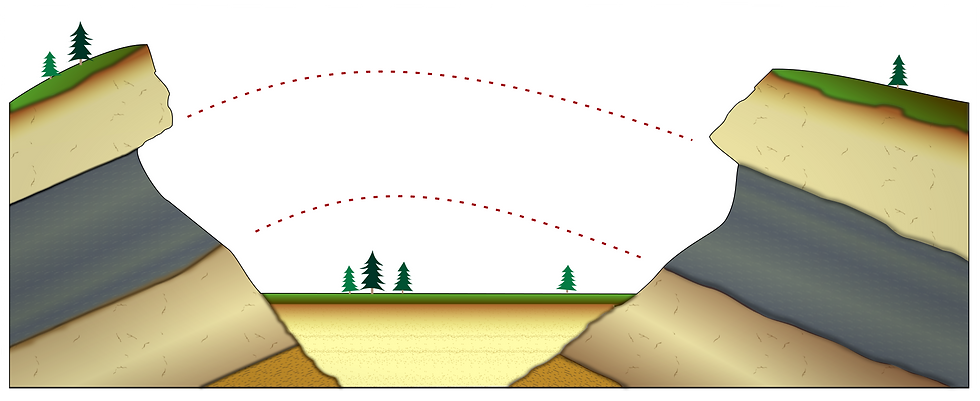The Age of Humans: Are We in a New Geological Epoch?
- jordanhealey5
- Jul 31, 2021
- 4 min read
A great debate in recent years has unfolded regarding the proposed Anthropocene epoch or the ‘Age of Humans’. Epochs are subdivisions of the geological timeline that highlight significant changes in geological or environmental conditions. This is usually a climate change event that is recognised by a distinct chemical signature in the rock or fossil record. A rock unit must fulfil a set of requirements such as containing a clear and globally-occurring signature, such as the first appearance of a fossil species, before it is ratified by a panel of scientists - the International Commission on Stratigraphy (stratigraphy refers to the branch of geology that correlates rocks to the time period they are from and their spatial distribution). When the panel decides that these requirements are fulfilled, a “golden spike” is assigned at an ideal locality to represent a boundary in time – unifying the rock record and time record to construct a stratigraphic column that records different subdivisions of time in Earth history.

Figure 1 example of a Golden Spike marking the beginning of the Ediacaran approximately 635 million years ago. Located in Flinders Ranges, South Australia.
The current epoch - the Holocene - began 11,650 years ago following the last Ice Age. Whether or not we are in a new epoch has been contested for many years now as it becomes more evident that we are changing the planet by influencing the climate, altering many of its natural cycles e.g. the water cycle in addition to impacting other forms of life on a massive scale. Scientists, such as the late Nobel Prize winning environmental chemist Paul J. Crutzen, have pushed the idea that industrial activity and farming has been a major driving factor on the planet’s atmosphere and biosphere, to the extent where we will be recognisable on the geological timeline millions of years from now. The last 540 million years can be broken down into only 38 epochs, averaging 14.2 million years each, so this hypothesis has garnered lots of attention in the media and scientific communities. The Anthropocene Working Group was formed in 2008 to determine whether the Anthropocene can be formally defined; this group currently has 38 members, all of whom are responsible in some way for the Geological Time Scale. In 2015, climate scientists Simon Lewis and Mark Maslin published a paper considering a major question in formally defining the Anthropocene: when did it begin?
The answer is steeped in almost as much debate as the question of whether the Anthropocene is a suitable epoch. While many people pinpoint the industrial revolution as the starting point of our influence on the environment, the reality is that the impact of the industrial revolution has been cumulative, and no significant point of change can be directly quantified. It is therefore difficult to assign a ‘Golden Spike’. Despite the Industrial Revolution offering no clear reference point, there was a noticeable decline in CO2 found in an Antarctic ice core that dates back to 1610, which predates the industrial revolution by only 150 years and sits between the “Colombian Exchange” and the industrial revolution – two pivotal historical moments in terms of human impact. Since this change is preserved in the geological record, it meets the required rules. Lewis and Maslin concluded that this would be one of the two most appropriate times to mark the beginning of the Anthropocene.
The second proposed reference point is the Great Acceleration - a term used to describe the rapid increase in population and consumption since 1950. Many believe that the finite limits of the planet are dangerously close to being reached, while the population continues to grow along with consumerism, showing no signs of stopping any time soon. This event also coincides with the first nuclear bomb test which occurred on July 16 1945 (the date Crutzen believed marks the start of the Anthropocene). This detonation and subsequent nuclear weapon detonations during World War II and the Cold War will leave their mark on the geology, this can be identified by an abundance of Carbon – 14 and radioactive material in the soils there was an identifiable peak of C-14 concentrations in 1964. While potentially recognisable millions of years from now, this ‘Golden Spike’ is favoured by 2/3 of the current members of the Anthropocene Working Group since it marks the most significant and rapid change in the relationship between humans and nature.
A third theory is known as the ‘Early Anthropocene’ which began around 5000-8000 years ago when wide scale farming and forest clearing began to change the levels of methane and CO2 in the atmosphere. One rise in methane levels occurred 5020 years ago and is believed to be due to a rise in farming, particularly of rice. This theory does however lack credibility in relation to the others according to Lewis and Maslin and so they reject it on the basis the cause is unclear.
More recently, the Great Acceleration is the more widely accepted reference point however there is still a great deal of misrepresentation of the word Anthropocene and its geological origins – a recent paper by Jan Zalasiewicz and colleagues aims to clarify the term and resolve this issue. The central idea puts into perspective how great an impact humanity has caused on the planet in such a short period of time. This should motivate enough people to agitate for change and hopefully undo some of the problems that result from exploitation of the Earth’s resources and its natural systems. One of the most fascinating parts of geology is that you appreciate the holistic nature of the planet and how inter-connected the rocks, water, ice, atmosphere, and biosphere are. This makes it all the more important that we take care of it.
Sources:


Comments